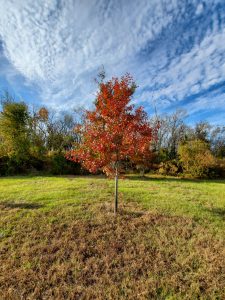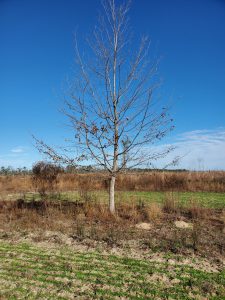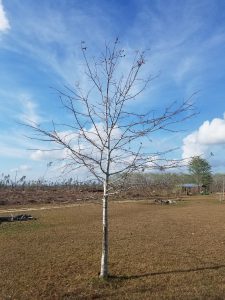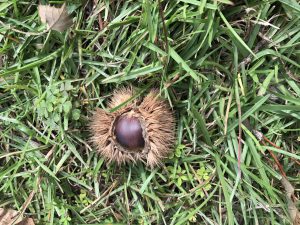One of the keys to bagging a deer or mess of squirrels or just enjoying an afternoon viewing wildlife is to locate their preferred food source. In the Panhandle, this often means finding a natural stand of oaks or other mast producing trees. However, the concept of attracting animals to mast trees isn’t exclusive to natural areas; it can be replicated by hunters and wildlife enthusiasts to attract whitetail deer, squirrels, turkeys or any other game. (Don’t let the terminology confuse you, “mast” is just a term meaning “fruit from a tree”. “Hard” mast refers to nut producing trees -think Oak, Hickory, etc. Soft mast is just that, soft-fleshed fruits – think Pear, Plum, etc. This piece will focus on hard mast trees.) Regardless of semantics, the takeaway is that planting mast producing trees as winter wildlife attractants have several benefits.
- Enhanced habitat. Planting diverse groups of hard mast producing trees provides wonderful cover for deer to browse, squirrels to nest, and turkeys to roost. Also, groups of trees planted in open areas can help to create desired edge effects, see this publication on benefits of “edge” from Auburn University.
- Excellent nutritional supplement to winter food-plot forages (winter food plots are defined here as open areas planted in the cool season with small forage grains like oats, clover, or ryegrass). If a diversity of species is planted, hard mast trees are an excellent, season-long (approximately October-January) source of proteins and fats. They produce high-energy nutrients deer and other critters need to get through the winter months.
- Reduction in time and money needing to be spent maintaining annual food plots. A well-designed grove of mast producing trees can be as effective in attracting deer and other animals as winter grazing plots and a whole lot cheaper. A study done by the University of Tennessee Extension in 2008 found that hunters spent about $200 per acre on winter food plots (seed, fertilizer, equipment, time, etc.), an expense that will happen EVERY year. And as many of you know from personal experience, $200 is a VERY conservative number, particularly if you value your personal time at all. Replacing half an acre of cultivated winter forage with mast trees will likely be more expensive in year one when you initially buy and plant but remember, if you do it right, you only have to do it once.
With those benefits of mast trees for wildlife attraction in mind, let’s address what and how to plant. Always select trees with desirable characteristics: long-lived, disease-free, and high-quality mast production at an early age (you don’t want your heirs to get all the benefit!). In the Panhandle, Oaks (Quercus spp.) fit this bill best. There are two groups of Oak to pick from, Red and White. Red Oaks generally have dark, ridged bark, leaves with pointed lobes, small to medium-sized acorns that mature in two seasons, and tend to crop reliably each year. White Oaks possess lighter colored bark, leaves with rounded lobes, large, “sweet” acorns maturing in one season, and tend to produce heavily in alternate years. Plant some of each group to ensure an acorn crop each year and maximize wildlife benefit! However, not just any old oak will do; the Oaks that most closely fit all the above characteristics are:
Nuttall Oak (Quercus nuttalli) – Red Oak Group. Rapidly growing, attractive tree, very early producer of good-sized acorns (5-6 years). Drops acorns late, providing needed fats and carbohydrates for bucks through much of the “rut” in the Panhandle (Late November-early February). Tolerates flooding and bottomland areas well.
White Oak (Quercus alba) – White Oak Group. Long-lived, stately tree. Relatively early producer of very large, sweet acorns. Acorn drop is earlier than Nuttall Oak. Grows best on moist upland soils.
Swamp Chestnut Oak (Quercus michauxii) – White Oak Group. Large tree with flaky white/gray bark. Relatively early producer of massive, prized acorns. Acorn drop occurs around the same time as White Oak. Prefers moist upland soils like its cousin the White Oak but will tolerate periodic flooding.
Sawtooth Oak (Quercus acutissima) – White Oak Group. Non-native. Medium-sized tree with heavy branches, often full to the ground. Very early and reliable producer of large, sweet acorns (begins producing at 5-6 years). Begins to drop acorns in September – often the first Oak to produce mast in the season. Grows best on moist upland soils.
Chinese Chestnut and Chinese/American Hybrids (Castanea spp.) – Not oaks but worthy of inclusion. Non-native or native hybrids. Medium-sized, spreading trees. Earliest producer of mast (3-4 years from seed germination). Highly sought-after by deer. Tolerates poor soils well but best production is in moist upland areas. I’m particularly partial to the newer American/Chinese Chestnut hybrids like ‘Dunstan’ and ‘AU Buck’.
It is important to remember that success starts at planting. Select healthy container or bare-root trees in the dormant season (December-February) and plant soon after to ensure the rootball doesn’t dry out. Dig planting hole the same depth plants are in containers or to depth of topmost root and backfill with native soil. Do not amend with compost or potting soil! After planting, the trees will need supplemental water, a few gallons per week, unless significant rainfall is received. Water regularly until establishment (when they no longer need your help, generally three-six months after planting).
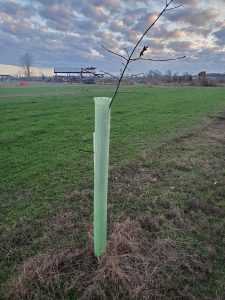
4′ tree grow tubes are effective at protecting young trees from deer browsing. Photo courtesy the author.
Also, recently planted seedlings will need protection from deer browsing. Unfortunately, deer don’t realize these trees will directly benefit them in a few years and will do their best to destroy them by eating the tender new growth or “rubbing” with their antlers, girdling the trees in the process. I’ve found that either a small 4’ high wire cage held together with zip ties works well, as do plastic grow tubes sold by many wildlife providers. If you opt to use grow tubes, secure them with a substantial staking material such as PVC, always carefully look inside when working around the trees as tubes are magnets for wasp nests, and be vigilant in keeping fire ants out (they enjoy building their homes inside the tree tubes, the nests will often reach several feet up the tube, causing major problems for the tree!) Finally, to maximize growth rate of your trees and expedite the mast-producing process, remove competition from the base of trees by pulling weeds or herbicide application and fertilize regularly (when growth emerges in the spring, again in early summer, and again in late summer to early fall).
As always, if you have any other questions or want more information, contact your local UF/IFAS Extension Office. Happy planting!
- Is it Colder than Last Year?What the Data Says. - January 17, 2025
- Florida’s Fall Foliage – Why 2024 Brought the Best Show in Recent History - December 20, 2024
- Poor Food Plot Performance – 3 Simple Solutions to Common Problems - January 12, 2024

